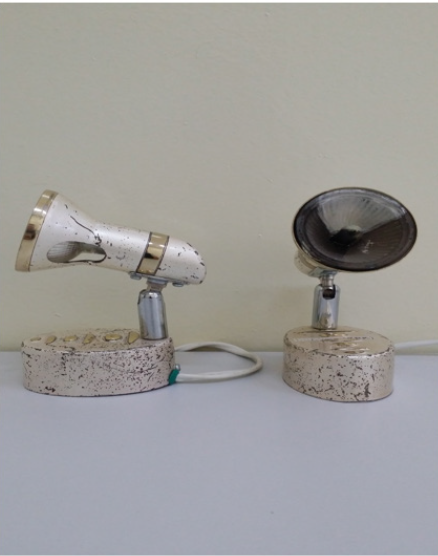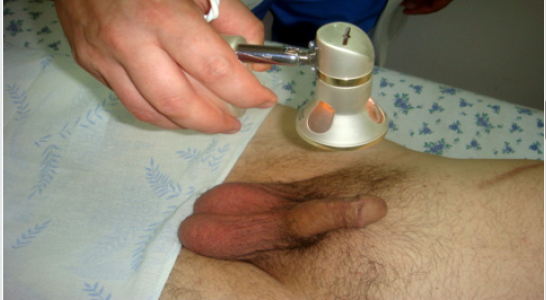Lupine publishers | Journal of Urology & Nephrology Studies
Goal: To identify influence of long range infra-red radiations on endothelium- dependent vasodilatation in patients with erectile disorders.
Material and Methods: One hundred eighteen males with erectile disorders were examined. Twenty practically healthy males comprised a control group. An endothelial function of the cavernoma arteries was determined with ultrasonic Diplography after of application of a long range infra-red radiation.
Results: An endothelial dysfunction of the cavernous arteries revealed with a Drug-Diplography method in the main group was also proved at the use of the original technique. Paradoxical vasoconstriction which was found during utilization of drug-induction method assay was identified in some patients. A direct correlation between these techniques was revealed and the correlation ratio was r=0.58 (p<0.05).
Conclusion: The method developed is informative in diagnostics of endothelial dysfunction of the cavernoma arteries, and we think that it will take a relevant place in a comprehensive examination of patients with erectile disorders.
Keywords: long range infra-red radiation; erectile dysfunction; endothelial dysfunction.
Introduction
All studies were carried out by one specialist in ultrasound diagnostics. The study was carried out in the morning, before the study, patients were advised to refrain from smoking and taking medications that affect the cardiovascular system. The average values of this indicator were calculated for the control group and patients with arterial and non-arterial ED. Statistical analysis was performed using t-student criterion and Pearson correlation coefficient. For analysis, computer software Statistica 6.0 was used; p <0.05 was recognized as statistically significant.
Results
divided into 2 subgroups: subgroup I - non-arterial ED of 42 patients (peak systolic velocity of 30 cm / s or more); Subgroup II - arteriogenic ED of 76 patients (peak systolic velocity less than 30 cm \ s). A comparative analysis of the average PUDA values in patients with different forms of ED revealed that this indicator is statistically significantly (p <0.001) less in the group of patients with arteriogenic ED compared with the control group, as well as in comparison with patients with other forms ED. An analysis of the data made it possible for us to propose a threshold level of PUDA for distinguishing organic ED from other forms of erectile disturbances, which amounted to 30%. The sensitivity and specificity of this indicator relative to the results of FDG in the diagnosis of arteriogenic ED were 100% and 96%, respectively. In patients with arteriogenic ED there was a significant correlation (r = 0.58 p <0.05) with the results of FDG (peak systolic rate) and PUDK values. An analysis of the results showed that the proposed method reveals a paradoxical vasoconstriction of the cavernous arteries, which is not determined when using FDG. When conducting the proposed diagnostic method, in no case did we observe complications and adverse reactions.
Discussion
The present study shows that the use of long-range IR emitters in determining the endothelial function of the cavernous arteries using ultrasound is a highly informative method for the diagnosis of arteriogenic ED. The developed technique for studying the endothelial function of the cavernous arteries has advantages over FDG and post-occlusion test, as it is a non-invasive method and technically simple to perform. It is known that the functional state of penile arteries depends on the biological activity of NO. Endothelial cells and nerve endings of non-cholinergic nonadrenergic neurons are sources of NO in the cavernous tissue of the penis. The synthesis of NO is carried out as a result of the action of enzymes of endothelial and neuronal NO synthase [14,15]. In our opinion, endothelial and neuronal NO synthases are activated by the quantum energy of the IR emitter, which leads to the release of NO. It is known that the quantum energy of radiation is inversely proportional to the wavelength, and if you take this into account, the effect on a person with radiation in the range of 8-9.8 μm (human own radiation is in the range of 9-10 μm) does not have negative side effects, since quantum energy of such sources does not exceed the quantum energy of the skin’s own radiation. The radiation of ceramic infrared emitters has a specific wavelength in the narrow spectral range. All types of emitters are characterized in that the energy spectrum of their exposure corresponds to or below the energy spectrum of human radiation. Emitters in these ranges have no effect on a healthy person, since it is transparent to them [16,17]. The paradoxical vasoconstriction detected by the proposed method is due to the presence of oxidative stress. Longrange infrared radiation stimulates the production of superoxide radicals (NO; O) by blood phagocytes and tissue macrophages, which enhances oxidative stress. This is not observed during FDG. Endothelial dysfunction is an early stage of atherosclerosis and is systemic in nature. Functional damage to most arterial vessels often proceeds without clinical symptoms; therefore, the timely detection of early stages of vascular system damage is relevant. In our opinion, the developed method for determining the endothelial function of the cavernous arteries is able to detect endothelial dysfunction at the level of functional disorders, which is not always determined with FDG.
Conclusion
Thus, our proposed method for studying the endothelial function of the cavernous arteries after exposure to a far-infrared emitter is highly informative in the diagnosis of arteriogenic ED, especially in the stage of functional disorders. This method will take its place in a comprehensive examination of patients with ED. Conflict of interest. The author claims no conflict of interest.
Acknowledgment
To the Head of the Clinical and Diagnostic Department of the Central Clinical Hospital No. 1 of the Main Medical Directorate under the Office of the President of the Republic of Uzbekistan, Doctor of Medical Sciences G. A. Rozykhojaeva.
https://twitter.com/lupine_online


